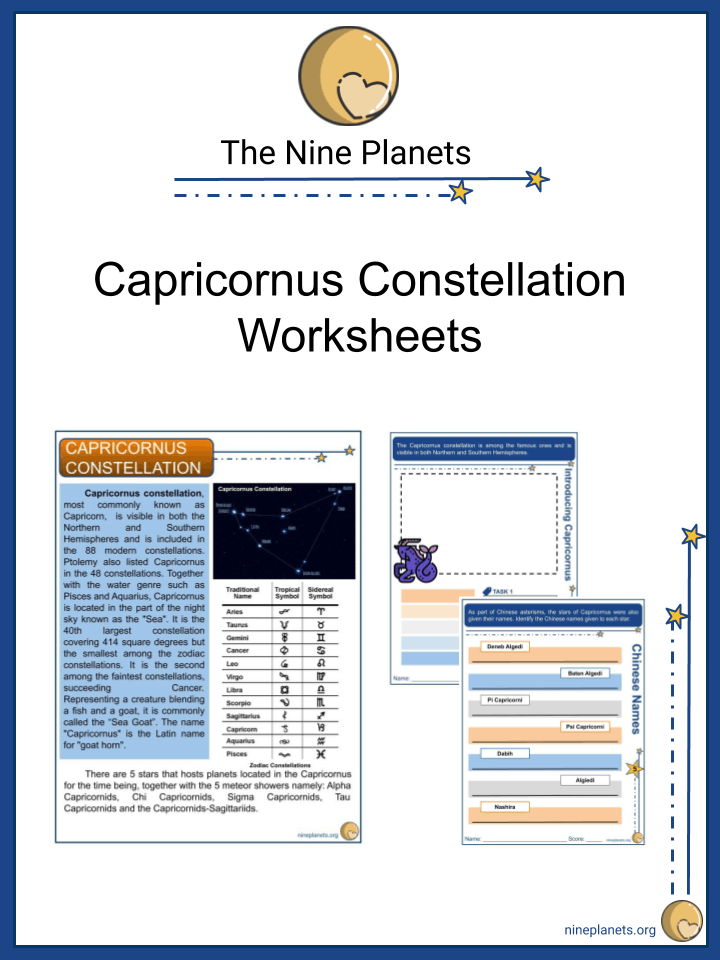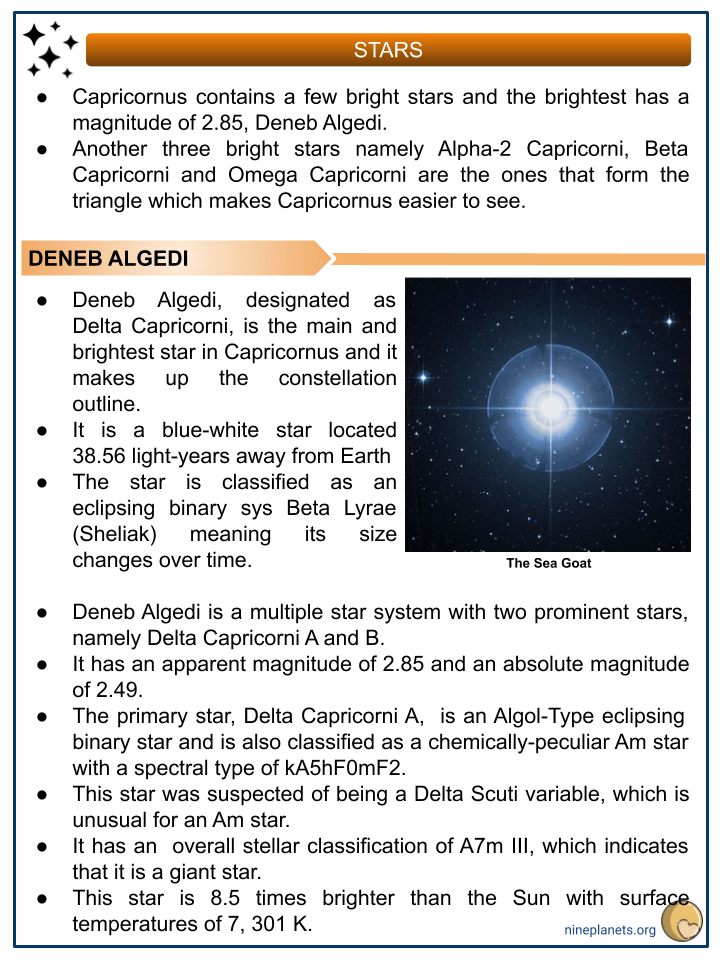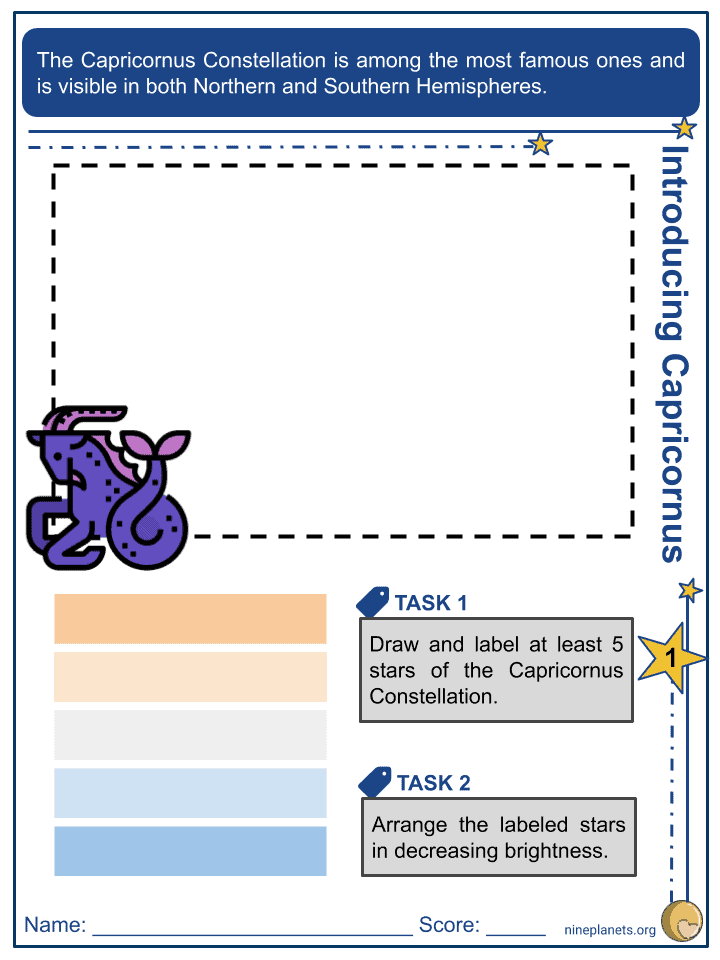Download Capricornus Constellation Worksheets
Click the button below to get instant access to these premium worksheets for use in the classroom or at a home.

This worksheet can be edited by Premium members using the free Google Slides online software. Click the Edit button above to get started.
Download free sample
Not ready to purchase a subscription yet? Click here to download a FREE sample of this worksheet pack.
Resource Examples
Click any of the example images below to view a larger version.




Key Facts & Information
- Capricornus Constellation, most commonly known as Capricorn, is visible in both the Northern and Southern Hemispheres and is included in the 88 modern constellations. Ptolemy also listed Capricornus in the 48 constellations. Together with the water elements such as Pisces and Aquarius, Capricornus is located in the part of the night sky known as the “Sea”. It is the 40th largest constellation covering 414 square degrees, but the smallest among the zodiac constellations. It is the second among the faintest constellations, succeeding Cancer. Representing a creature combining a fish and a goat, it is commonly called the “Sea Goat”. The name “Capricornus” is the Latin name for “goat horn”.
- There are 5 stars that host planets located in the Capricornus Constellation for the time being, together with the 5 meteor showers namely: Alpha Capricornids, Chi Capricornids, Sigma Capricornids, Tau Capricornids and the Capricornids-Sagittariids.
History And Mythology
- Capricornus was viewed as a half-goat and half-fish by the Sumerians and they called it SUHUR-MASH-HA.
- The Babylonians portrayed it as a goat-human hybrid with the name of MUL.SUHUR.MAS.
- The Greeks associated Capricornus with Pan, the god of nature.
- Pan is the one who suggested that they all, together with the Olympian Gods, transform themselves into animals to hide from the monster Typhon, who was sent by Gaia (Mother Earth) to attack them.
- He jumped into the Nile River and only half of his body was submerged, so he transformed the part of his body that was underwater into a fish.
- He then saw Typhon fighting with Zeus so he blew a shrill note on his pipes, which apparently made the monster flee.
- Zeus turned Pan into one of the zodiac signs in appreciation of his heroic deed.
- However, some say it is connected to Amalthea who was Zeus’s foster mother when he was an infant.
- Capricornus is also known as the “Gate of the Gods”, where the souls of the dead return to heaven in Greek mythology.
- Based on astrology, the appearance of this constellation marks the first day of winter.
Stars
- Capricornus contains a few bright stars and the brightest has a magnitude of 2.85, Deneb Algedi.
- Another three bright stars namely Alpha-2 Capricorni, Beta Capricorni and Omega Capricorni are the ones that form the triangle which makes Capricornus easier to see.
- DENEB ALGEDI
- Deneb Algedi, designated as Delta Capricorni, is the main and brightest star in Capricornus and it makes up the constellation outline.
- It is a blue-white star located 38.56 light-years away from Earth
- The star is classified as an eclipsing binary sys Beta Lyrae (Sheliak) meaning its size changes over time.
- Deneb Algedi is a multiple star system with two prominent stars, namely Delta Capricorni A and B.
- It has an apparent magnitude of 2.85 and an absolute magnitude of 2.49.
- The primary star, Delta Capricorni A, is an Algol-Type eclipsing binary star and is also classified as a chemically-peculiar Am star with a spectral type of kA5hF0mF2.
- This star was suspected of being a Delta Scuti variable, which is unusual for an Am star.
- It has an overall stellar classification of A7m III, which indicates that it is a giant star.
- This star is 8.5 times brighter than the Sun with surface temperatures of 7, 301 K.
- It’s solar radii is 1.91 and its mass is 2 times that of the Sun’s.
- The primary star is much hotter and is spinning faster than the Sun with a rotational velocity of 105 km.
- Delta Capricorni B is smaller and cooler than our Sun, covering 73% of its mass and 90% of its radius.
- The secondary stars have surface temperatures of 4, 500 K.
- “Deneb” is the Arabic word for “tail” since the position of the star marks the tail of the goat.
- In Chinese astronomy, it is known as The Fourth Star of the Line of Ramparts – an asterism consisting of Deneb Algedi, Nashira, Hydor, Kappa Capricorni, Epsilon Capricorni, Iota Aquarii, Sigma Aquarii, Phy quarii, 27 Piscium, 29 Piscium, 33 Piscium, 33 Piscium and 30 Piscium.
- DABIH
- Dabih, designated as Beta Capricorni, is a multiple star system that consists of 5 stars.
- It can be found 328 light-years away from the Sun and it is near the ecliptic, which can make it occulted by the Moon.
- Beta Capricorni has two constituents which are Beta1 and Beta 2, also named Dabih Major and Dabih Minor.
- Beta1 Capricorni, or Dabih A, is brighter than the latter with an apparent magnitude of 3.05 and an absolute magnitude of -2.03.
- It is of spectral type K0II+B8V.
- Dabih Major holds two dominant stars namely Beta Capricorni Aa and the Beta Capricorni Ab1, which are separated by 0.05 arcseconds (5 AU).
- Dabih Aa is an orange K-type bright giant with an apparent magnitude of 3.08.
- This star’s luminosity is 600 times of that of the Sun, with a temperature of 4900 K. Its’ solar radii is 35.
- Dabih Ab1 is a blue-white B-type main-sequence dwarf with an apparent magnitude of 7.20.
- The star has an unseen companion called Beta Capricorni Ab2, which orbits Ab1 with an orbital period of 8.7 days.
- Beta2 Capricorni or Dabih B, the other constituent, has an apparent magnitude of 6.09 and it contains two components as well: Beta Capricorni Ba and Bb.
- It has an absolute magnitude of 1.03 of spectral type A0III
- The are other two nearby stars discovered by John Herschel, which are referred to as Beta Capricorni D and E.
- It is still unknown if these stars are simply optical doubles or part of star system of Dabih.
- The name “Dabih” originated from the Arabic “al-dhabih” meaning “the butcher”.
- In chinese, it is known as the First star of the Ox – an asterism consisting of Dabih, Algedi, Oculus, Bos, Xi2 Capricorni, and Omicron Capricorni.
- ALGIEDI
- Algiedi, designated as Alpha Capricorni, is an optical double star with components Alpha1 and Alpha-2 Capricorni.
- Alpha1 Capricorni is speculated to be a multiple star system dominated by a highly luminous star.
- The primary star is a yellow supergiant of spectral type G3 Ib.
- It has an apparent magnitude of 4.27 and an absolute magnitude of -1.90.
- Despite being only 5.3 times more massive than the Sun, it is 1,047 times brighter.
- The star has surface temperatures of 5,300 K and a rotational velocity of 7.3 km.
- Alpha1 has the traditional names Prima Giedi and Algiedi Prima.
- Alpha-2 Capricorni, the known “Algedi”, is a triple star system located at around 102 light-years away from us.
- The stars system has an apparent magnitude of 3.57 and each star has an absolute magnitude of 0.98, 0.07, and -0.06 respectively.
- Its primary star, Alpha-2 Capricorni A, has an estimated mass of 205% of the Sun’s mass and 838% of its radius.
- It is 40.4 times brighter than our Sun with estimated surface temperatures of 5,030 K.
- Algedi A is of spectral type G8.5III-IV, which indicates that the spectrum displays mixed traits of a giant and a subgiant star.
- The star is a slow spinner with rotational velocity of 2.7 km and has a surface gravity of 3.0 cgs.
- Algiedi means “the billy goat” in Arabic and it is known as The Second Star of The Ox in Chinese astronomy.
- NASHIRA
- Nashira, designated as Gamma Capricorni, is a hot chemically peculiar Am star with an apparent magnitude of 3.67 and an absolute magnitude of 2.60.
- Gamma Capricorni is located 139 light-years away from us.
- It is classified as an a2 Canum Venaticorum variable star in which its brightness varying by 0.03 magnitudes.
- The star has a radial velocity of -31.2 km and a temperature of 7, 520 K.
- Its traditional name Nashira is derived from the Arabic meaning “the lucky one” or “bearer of good news”.
- In Chinese, it is known as the Third Star of Line of Ramparts, in line with Deneb Algedi.
- ZETA CAPRICORNI
- Zeta Capricorni is a star system composed of 2 components with an apparent magnitude of 3.74 and an absolute magnitude of -1.59.
- Zeta Capricorni A, the primary star, is a yellow G-type giant of spectral type G8IIIp and has an apparent magnitude of 3.77.
- It is also classified as a Barium star because of its abundance of carbon molecules and s-process elements.
- Capricorni B, its companion, is a hydrogen-rich white dwarf with a temperature of 23,000 K.
- This star system has an orbital period of 2,378.2 days and is 390 light-years away from Earth.
- In Chinese Astronomy, it belongs to the asterism Twelve States that represents the ancient states during the Spring and Autumn period and the Warring States Period and represents the state of Yan, with Nu Ophiuchi in Left Wall of Heavenly Market Enclosure.
- DORSUM
- Dorsum, designated as Theta Capricorni, is a A1V main- sequence star with an apparent magnitude of 4.07 and an absolute magnitude of 0.60.
- The star’s colour is blue-white and it has a temperature of around 10,001 K.
- Dorsum spins fast, having a rotational velocity of 104 km/s and it is 162.19 light-years away from us.
- Theta Capricorni’s luminosity is 58.42 and it has a solar radii of 2.46.
- Its radial velocity of -10.9 suggests that it may be a binary system, but no companion was detected in the infrared examination,
- Dorsum is also included in the Chinese Twelve States and represents the state Qin with Delta Serpentis in the Right Wall of Heavenly Market.
- BATEN ALGIEDI
- Baten Algiedi is also known as Omega Capricorni and is an M-type red giant star, approximately 630 light-years from Earth.
- It has an apparent magnitude of 4.12 and an absolute magnitude of -2.7.
- The star is 6,269 times brighter than the Sun and about 6.8 more massive.
- Omega Capricorni has 17,210%
- of the solar radius and a temperature
- of 3,915 K.
- It is suspect to be a barium star due to the overabundance of s-process elements, suggesting that it has an orbiting white dwarf companion.
- The name Baten Algiedi means “the belly of the goat” in Arabic.
- In Chinese, it is known as the First Star of Celestial Farmland – asterism consisting of Omega Capricorni, Psi Capricorni, 24 Capricorni, and 3 Piscis Austrini.
- PSI CAPRICORNI
- Psi Capricorni is a yellow-white hued main-sequence star, with an apparent magnitude of 4.13 and is of stellar type F5 V.
- The distance from this star is approximately 47.9 light-years and it has a radial velocity of 20 km.
- Psi Capricornis’s solar mass is 1.37 and it has a solar radii of 1.51.
- It is 3.82 times brighter than our Sun, having a temperature of 6,572 K.
- The star is speculated to have an orbiting debris around 38.75 AU away and a temperature of 60 K.
- In Chinese, it is known as the Fourth Star of Celestial farmland, in line with Omega Capricorni.
- PI CAPRICORNI
- Pi Capricorni is a triple star system visible to the naked eye located around 660 light-years away, drifting closer with a radial velocity of 13 km.
- This system has an apparent magnitude of 5.096 and an absolute magnitude of -1.01.
- The primary star, Pi Capricorni Aa, is a blue-white bright giant or main-sequence star.
- The star’s solar mass is 5.9 with a temperature of 9,623 K.
- It is a spectroscopic binary with two components separated by 0.1 arcseconds.
- Pi Capricorni is also known as Oculus, meaning “eye” in Latin.
- In Chinese, it is known as the Fourth Star of Ox.
Celestial Objects
- Aside from the 5 stars that host planets and the meteor showers, Capricornus also contains interesting deep-sky objects.
- Messier 30 is a globular cluster of stars located at the southern part of the constellation located around 27,100 light-years away from Earth.
- NGC 6907 is a spiral galaxy with two spiral arms and an inner bulge located around 118 million light-years away.
- HCG 87 is a compact group of galaxies approximately 400 million light-years away.
- It hosts two active galactic nuclei and a starburst.
- IC 1337 is an intermediate spiral galaxy 420 million light-years away from us.
Did You Know?
- The Nakh people called Capricornus the Roofing Towers.
- In 1846, Neptune was discovered while it was near Deneb Algedi.
- The Babylonians associated Capricorn as a symbol of Ea.
- In Chinese astronomy, Capricornus is located in the Black Tortoise of the North and is also called the rub ram constellation.